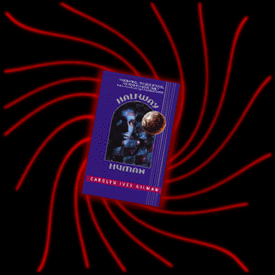 Nonetheless Gilman likes her day job. "Sometimes I can't figure out how I lucked into such a good position. I've been developing exhibits on Native Americans and exploration for twenty years. Even though I'm not a trained anthropologist I've been doing a lot of anthropology. And I've known a lot of anthropologists and their techniques."
Nonetheless Gilman likes her day job. "Sometimes I can't figure out how I lucked into such a good position. I've been developing exhibits on Native Americans and exploration for twenty years. Even though I'm not a trained anthropologist I've been doing a lot of anthropology. And I've known a lot of anthropologists and their techniques."
That second-hand knowledge shows through in her book. Halfway Human takes place in part on planet Gammadis, where humans manifest three genders -- male, female, and asexual, or "bland," as it is known there. The Gammadians are of consuming interest to a group of anthropologists from planet Capella Two.
"As a matter of fact, there's a great similarity between doing exhibits and doing fiction," Gilman continues. "Our exhibits are all about the exploration of new civilations and worlds. The Arikara Indians of North Dakota, for instance, are more alien than most aliens created by SF writers. There are so many tribes that nobody has ever heard of."
Gilman has been publishing science fiction and fantasy in the magazine venue for a decade, and was a finalist for the Nebula Award in the novelette category in 1992. "I can't remember when I first started to write, it was that early," Gilman recalls. "In college I started out in theater, but switched to English because I was more interested in reading and writing than performing. I'd been an avid SF and fantasy reader, and when I was in my twenties, it finally dawned on me: 'Why shouldn't I write the stuff that I read?' "
Halfway Human, Gilman's first published novel, reflects not just her love for science fiction, but also a nostalgia for the worlds she inhabited before. She grew up in St. Paul and has lived much of her life along the Mississippi; in Halfway Human, the landscape of Gammadis is partly reminiscent of the Mississippi Valley. Another part of the planet's landscape is inspired by the great plains of North Dakota, where she also spent a lot of time.
Some readers might describe Halfway Human as "issue driven," tackling subjects from race and gender to class and politics, but Gilman doesn't see it quite that way. "I didn't deliberately attempt to deal with any particular issues," she explains. "The narrative reflects things uppermost in my mind during the time I was writing the book. I was, as a matter of fact, a little disappointed I wasn't able to work in more about gender. Actually, gender falls by the wayside, and the story becomes much more about power. It was a character-driven book," she says, "and the characters didn't want me to go that particular way."
These days Gilman is organizing a major exhibit on the Lewis and Clark expedition for the Missouri Historical Society. "I'm getting to work with all the ethnographic objects, botanical specimens, and artifacts Lewis and Clark collected," she says, "and all of their journals." It can only feed her fiction.
The current work in progress is another novel, with the tentative title Dark Orbit, about a mission to explore a world where the inhabitants are blind. "The civilization there is completely adapted to sightlessness," she says. "For instance, they have not developed the discipline of geography -- they do not perceive space the same way we do. That leads to some rather interesting conclusions about the nature of reality."
In the end, adds Gilman, "the book is really about how the explorers react to what they learn about themselves."
|

